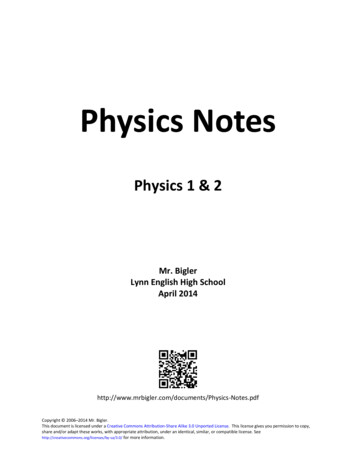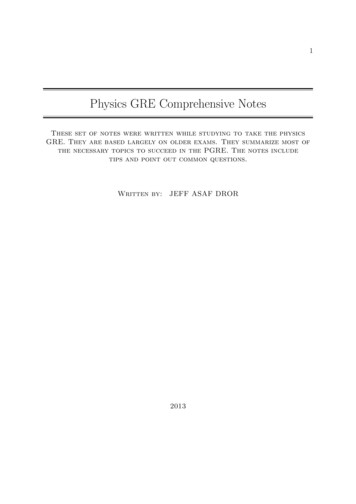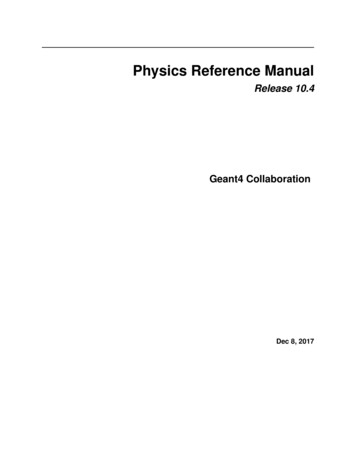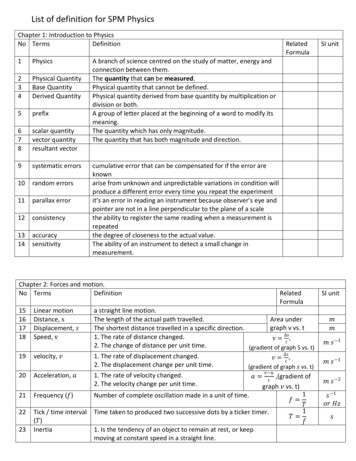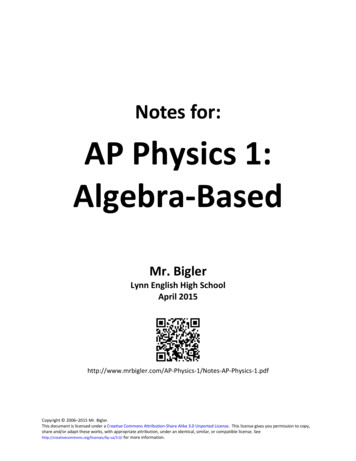
Transcription
Notes for:AP Physics 1:Algebra-BasedMr. BiglerLynn English High SchoolApril Physics-1.pdfCopyright 2006–2015 Mr. Bigler.This document is licensed under a Creative Commons Attribution-Share Alike 3.0 Unported License. This license gives you permission to copy,share and/or adapt these works, with appropriate attribution, under an identical, similar, or compatible license. Seehttp://creativecommons.org/licenses/by-sa/3.0/ for more information.
AP Physics 1Page 2This book is the property of:Book No.:Issued toAP Physics 1: nedMr. Bigler
AP Physics 1Page 3This is a set of class notes for AP Physics 1: Algebra-Based. This hardcopy is provided so thatyou can fully participate in class discussions without having to worry about writing everythingdown.These notes are meant to complement the textbook discussion of the same topics. In somecases, the notes and the textbook differ in method or presentation, but the physics is the same.There may be errors and/or omissions in the textbook. There are certainly errors and omissionsin these notes, despite my best efforts to make them clear, correct, and complete.As we discuss topics in class, you will almost certainly want to add your own notes to these. Ifyou have purchased this copy, you are encouraged to write directly in it, just as you would writein your own notebook. However, if this copy was issued to you by the school and you intend toreturn it at the end of the year, you will need to write your supplemental notes on separatepaper. If you do this, be sure to write down page numbers in your notes, to make crossreferencing easier.You should bring these notes to class every day, because lectures and discussions will followthese notes, which will be projected onto the SMART board.AP Physics 1: Algebra-BasedMr. Bigler
AP Physics 1Page 4Table of ContentsIntroduction . 5Laboratory & Measurement . 11Mathematics . 51Kinematics (Motion) . 97Forces . 133Rotational Dynamics . 181Work, Energy & Momentum . 207Electricity. 253Simple Harmonic Motion . 299Mechanical Waves . 311Pressure & Fluid Mechanics . 342Appendix: AP Physics 1 Equation Tables . 370Appendix: Reference Tables . 372Index. 387AP Physics 1: Algebra-BasedMr. Bigler
Cornell NotesAdd ImportantNotes/Cues HerePage: 5Unit: IntroductionCornell NotesUnit: IntroductionNGSS Standards: N/AMA Curriculum Frameworks (2006): N/AKnowledge/Understanding: how to take advantage of the Cornell note-taking systemLanguage Objectives: Understand the term Cornell Notes and be able to describe how CornellNotes are different from ordinary note-taking.Notes:The Cornell note-taking system was developed about fifty years ago at CornellUniversity. I think it’s a great way to get more out of your notes. I think it’s anespecially useful system for adding your comments to someone else’s notes(such as mine).The main features of the Cornell Notes system are:1. The main section of the page is for what actually gets covered in class.2. The left section (officially 2½ inches, though I have shrunk it to 2 inchesfor these notes) is for “cues”—questions or comments of yours that willhelp you find, remember, or effectively use these notes.3. The bottom section (2 inches) is officially for you to add a 1–2 sentencesummary of the page in your own words. This is a good idea. However,because the rest of the page is my notes, not yours, you may also want touse that space for anything else you want to remember that wasn’t in thepre-printed notes.Use this space for summary and/or additional notes:AP Physics 1: Algebra-BasedMr. Bigler
Reading & Taking Notes from a TextbookAdd ImportantNotes/Cues HerePage: 6Unit: IntroductionReading & Taking Notes from a TextbookUnit: IntroductionNGSS Standards: N/AMA Curriculum Frameworks (2006): N/ASkills: pre-reading and reading a section of a textbook and taking notesLanguage Objectives: understand and be able to describe the reading and note-taking strategiespresented in this sectionNotes:If you read a textbook the way you would read a novel, you probably won’tremember much of what you read. Before you can understand anything, yourbrain needs enough context to know how to file the information. This is whatAlbert Einstein was talking about when he said, “It is the theory which decideswhat we are able to observe.”When you read a section of a textbook, you need to create some context in yourbrain, and then add a few observations to solidify the context before reading indetail.René Descartes described this process in 1644 in the preface to his Principles ofPhilosophy:"I should also have added a word of advice regarding the manner of reading this work, whichis, that I should wish the reader at first go over the whole of it, as he would a romance,without greatly straining his attention, or tarrying at the difficulties he may perhaps meetwith, and that afterwards, if they seem to him to merit a more careful examination, and hefeels a desire to know their causes, he may read it a second time, in order to observe theconnection of my reasonings; but that he must not then give it up in despair, although hemay not everywhere sufficiently discover the connection of the proof, or understand all thereasonings—it being only necessary to mark with a pen the places where the difficultiesoccur, and continue reading without interruption to the end; then, if he does not grudge totake up the book a third time, I am confident that he will find in a fresh perusal the solutionof most of the difficulties he will have marked before; and that, if any remain, their solutionwill in the end be found in another reading."Use this space for summary and/or additional notes:AP Physics 1: Algebra-BasedMr. Bigler
Add ImportantNotes/Cues HereReading & Taking Notes from a TextbookPage: 7Unit: IntroductionThe following 4-step system takes about the same amount of time you’re used tospending on reading and taking notes, but it will probably make a tremendousdifference in how much you understand and remember.1. Copy the titles/headings of each section. Leave about ¼ page of spaceafter each one. (Don’t do anything else yet.) This should take about 2–3minutes.2. Do not write anything yet! Look through the section for pictures, graphs,and tables. Take a minute to look at these—the author must havethought they were important. Also read over (but don’t try to answer)the homework questions/problems at the end of the section. (For thevisuals, the author must think these things illustrate something that isimportant enough to dedicate a significant amount of page real estate toit. For the homework problems, these illustrate what the author thinksyou should be able to do once you know the content.) This processshould take about 10–15 minutes.3. Actually read the text, one section at a time. For each section, jot downkeywords and sentence fragments that remind you of the key ideas. Youare not allowed to write more than the ¼ page allotted. (You don't needto write out the details—those are in the book, which you already have!)This process is time consuming, but shorter than what you’re probablyused to doing for your other teachers.4. Read the summary at the end of the chapter or section—this is what theauthor thinks you should know now that you’ve finished the reading. Ifthere’s anything you don’t recognize, go back and look it up. This processshould take about 5–10 minutes.You shouldn’t need to use more than about one sheet of paper (both sides) per10 pages of reading!Use this space for summary and/or additional notes:AP Physics 1: Algebra-BasedMr. Bigler
Taking Notes on Math ProblemsAdd ImportantNotes/Cues HerePage: 8Unit: IntroductionTaking Notes on Math ProblemsUnit: IntroductionNGSS Standards: N/AMA Curriculum Frameworks (2006): N/ASkills: taking notes on a mathematical problemLanguage Objectives: understand and be able to describe the strategies presented in this sectionNotes:If you were to copy down a math problem and look at it a few days or weekslater, chances are you’ll recognize the problem, but you won’t remember howyou solved it.Solving a math problem is a process. For notes to be useful, they need todescribe the process as it happens, not just the final result.If you want to take good notes on how to solve a problem, you need your notesto show what you did at each step.For example, consider the following physics problem:A 25 kg cart is accelerated from rest to a velocity of 3.5 ms over aninterval of 1.5 s. Find the net force applied to the cart.The process of solving this problem involves applying two equations:v vo at and F ma.Use this space for summary and/or additional notes:AP Physics 1: Algebra-BasedMr. Bigler
Add ImportantNotes/Cues HereTaking Notes on Math ProblemsPage: 9Unit: IntroductionA good way to document the process is to use a two-column format, in whichyou show the steps of the solution in the left column, and you write anexplanation of what you did and why for each step in the right column.For this problem, a two-column description would look like the following:Stepm 25 kgvo 0v 3.5 mst 1.5 sF quantity desiredF maDescription/ExplanationDefine variables.Choose a formula that contains F. See if we have theother variables. No. We need to find a before we can solvethe problem.v vo atChoose a formula that contains a. See if we have theother variables. Yes.3.5 0 a (1.5)3.5 1.5a3.5 1.5 a1.5 1.52.33 aSubstitute v, vo and t into the 1st equation and solvefor a.F maF (25)(2.33)F 58.33Substitute m and a into the 2nd equation and solvefor F.F 58.33 NInclude the units and box the final answer.Use this space for summary and/or additional notes:AP Physics 1: Algebra-BasedMr. Bigler
Introduction: Laboratory & MeasurementAdd ImportantNotes/Cues HerePage: 11Unit: Laboratory & MeasurementIntroduction: Laboratory & MeasurementUnit: Laboratory & MeasurementTopics covered in this chapter:Introduction: Laboratory & Measurement . 11The Scientific Method . 13Designing & Performing Experiments . 16Graphical Solutions . 21Accuracy & Precision. 22Uncertainty & Error Analysis. 24Keeping a Laboratory Notebook . 40Formal Laboratory Reports . 47The purpose of this chapter is to teach skills necessary for designing andcarrying out laboratory experiments, recording data, and writing summariesof the experiment in different formats. Designing & Performing Experiments discusses strategies for coming upwith your own experiments and carrying them out. Accuracy & Precision, Uncertainty & Error Analysis, and Recording andAnalyzing Data discuss techniques for working with the measurementstaken during laboratory experiments. Keeping a Laboratory Notebook and Formal Laboratory Reports discussways in which you might communicate (write up) your laboratoryexperiments.Calculating uncertainty (instead of relying on significant figures) is a new andchallenging skill that will be used in lab write-ups throughout the year.Standards addressed in this chapter:Next Generation Science Standards (NGSS):No NGSS standards are addressed in this chapter.Massachusetts Curriculum Frameworks (2006):Use this space for summary and/or additional notes:AP Physics 1: Algebra-BasedMr. Bigler
Add ImportantNotes/Cues HereIntroduction: Laboratory & MeasurementPage: 12Unit: Laboratory & MeasurementNo MA curriculum frameworks are specifically addressed in this chapter.Skills learned & applied in this chapter: Designing laboratory experiments Error analysis (calculation & propagation of uncertainty) Formats for writing up lab experimentsUse this space for summary and/or additional notes:AP Physics 1: Algebra-BasedMr. Bigler
The Scientific MethodAdd ImportantNotes/Cues HerePage: 13Unit: Laboratory & MeasurementThe Scientific MethodUnit: Laboratory & MeasurementNGSS Standards: N/AMA Curriculum Frameworks (2006): N/AKnowledge/Understanding Goals: Understand the scientific methodLanguage Objectives: Understand and correctly use terms relating to the scientific method, suchas “peer review”Notes:The scientific method is a fancy name for “figure out what happens by trying it.”In the middle ages, “scientists” were called “philosophers.” These were churchscholars who decided what was “correct” by a combination of observing theworld around them and then arguing and debating with each other about themechanisms and causes.During the Renaissance, scientists like Galileo Galilei and Leonardo da Vincistarted using experiments instead of argument to decide what really happens inthe world.Steps:1. Observe something interesting.2. Figure out and perform an experiment that will have different outcomesdepending on the parameter(s) being tested. You can make a claim thatdescribes what you expect will happen (sometimes called a hypothesis),or you can just perform the experiment to see what happens.3. Repeat the experiment, varying your conditions as many ways as you can.4. If you are testing a claim, assume that your claim is wrong. Try everyexperiment and make every observation you can think of that mightrefute your claim.Use this space for summary and/or additional notes:AP Physics 1: Algebra-BasedMr. Bigler
Add ImportantNotes/Cues HereThe Scientific MethodPage: 14Unit: Laboratory & Measurement5. If your claim holds, try to come up with a model that explains andpredicts the behavior you observed. This model is called a theory. If yourclaim holds but you cannot come up with a model, try to completely andaccurately describe the conditions under which your claim successfullypredicts the outcomes. This description is called a law.6. Share your theory, your experimental procedures, and your data withother scientists. Some of these scientists may:a. Look at your experiments to see whether the experiments reallycan distinguish between the different outcomes.b. Look at your data to see whether the data really do support yourtheory.c. Try your experiments or other related experiments themselvesand see if the results are consistent with your theory.d. Add to, modify, limit, refute (disprove), or suggest an alternativeto your theory.e. Not care in the slightest about your theory or your experiments.(Scientists are in no way obligated to spend their time testingsomeone else’s theories.)This process is called “peer review.” If a significant number ofscientists have reviewed your claims and agree with them, and noone has refuted your theory, your theory may gain acceptance withinthe scientific community.Note that the word “theory” in science has a different meaning from the word“theory” in everyday language. In science, a theory is a model that: Has never failed to explain a collection of related observations Has never failed to successfully predict the outcomes of relatedexperimentsFor example, the theory of evolution has never failed to explain the process ofchanges in organisms because of factors that affect the survivability of thespecies.If a repeatable experiment contradicts a theory, and the experiment passes thepeer review process, the theory is deemed to be wrong. If the theory is wrong, itmust be either modified to explain the new results or discarded completely.Use this space for summary and/or additional notes:AP Physics 1: Algebra-BasedMr. Bigler
Add ImportantNotes/Cues HereThe Scientific MethodPage: 15Unit: Laboratory & MeasurementNote that, despite what your ninth-grade science teacher may have taught you,it is possible (and often useful) to have a hypothesis or claim before performingan experiment, but an experiment is just as valid and just as useful whether ornot a hypothesis was involved.Theories vs. Natural LawsThe terms “theory” and “law” developed organically, so any definition of eitherterm must acknowledge that common usage, both within and outside of thescientific community, will not always be consistent with the definitions.A theory is a model that attempts to explain why or how something happens. Alaw simply describes what happens without attempting to provide anexplanation. Theories and laws can both be used to predict the outcomes ofrelated experiments.For example, the Law of Gravity states that objects attract other objects basedon their masses and distances from each other. It is a law and not a theorybecause the Law of Gravity does not explain why masses attract each other.Atomic Theory states that matter is made of atoms, and that those atoms arethemselves made up of smaller particles. The interactions between the particlesthat make up the atoms (particularly the electrons) are used to explain certainproperties of the substances. This is a theory because it gives an explanation forwhy the substances have the properties that they do.Note that a theory cannot become a law any more than a definition can becomea measurement or a postulate can become a theorem.Use this space for summary and/or additional notes:AP Physics 1: Algebra-BasedMr. Bigler
Designing & Performing ExperimentsAdd ImportantNotes/Cues HerePage: 16Unit: Laboratory & MeasurementDesigning & Performing ExperimentsUnit: Laboratory & MeasurementNGSS Standards: N/AMA Curriculum Frameworks (2006): N/ASkills: determine what you are testing figure out how to get from what you can measure to what you want todetermineLanguage Objectives: Understand and correctly use the terms “dependent variable” and“independent variable.” Understand and be able to describe the strategies presented in thissection.Notes:Most high school physics experiments are relatively simple to understand, set upand execute—much more so than in chemistry or biology. This makes physicswell-suited for teaching you how to design experiments.The education “buzzword” for this is inquiry-based experiments, which meansyou (or your lab group) will need to figure out what to do to perform anexperiment that answers a question about some aspect of physics. In thiscourse, you will usually be given only an objective or goal and a general idea ofhow to go about achieving it. You and your lab group (with help) will decide thespecifics of what to do, what to measure (and how to measure it), and how tomake sure you are getting good results. This is a form of guided inquiry.Use this space for summary and/or additional notes:AP Physics 1: Algebra-BasedMr. Bigler
Designing & Performing ExperimentsAdd ImportantNotes/Cues HerePage: 17Unit: Laboratory & MeasurementFraming Your ExperimentExperiments are motivated by something you want to find out, observe, orcalculate.Independent vs. Dependent VariablesIn an experiment, there is usually something you are doing, and something youare measuring or observing.independent variable: the conditions you are setting up. These are the numbersyou pick. Because you pick the numbers, they are independent of whathappens in the experiment. For example, if you are dropping a ball fromdifferent heights to find out how long it takes to hit the ground, you arechoosing the heights, so height is the independent variable.dependent variable: the things that happen in the experiment. These are thenumbers you measure, which are dependent on what happens in theexperiment. For example, if you are dropping a ball from different heights tofind out how long it takes to hit the ground, you are measuring the time,which depends on the height. This means time is the dependent variable.control variable: other things that could vary but are being kept constant. Theseare usually parameters that could be independent variables in otherexperiments, but are kept constant so they do not affect the relationshipbetween the independent variable being tested and the dependent variablebeing measured.If someone asks what your independent and dependent variables are, thequestion simply means, “What did you change (independent variable)?” and“What did you measure (dependent variable)?”Use this space for summary and/or additional notes:AP Physics 1: Algebra-BasedMr. Bigler
Designing & Performing ExperimentsAdd ImportantNotes/Cues HerePage: 18Unit: Laboratory & MeasurementQualitative ExperimentsIf the goal of your experiment is to find out whether or not something happensat all, you need to set up a situation in which the phenomenon you want toobserve can either happen or not, and then observe whether or not it does. Theonly hard part is making sure the conditions of your experiment don’t biaswhether the phenomenon happens or not.If you want to find out under what conditions something happens, what you’rereally testing is whether or not it happens under different sets of conditions thatyou can test. In this case, you need to test three situations:1. A situation in which you are sure the thing will happen, to make sure youcan observe it. This is your positive control.2. A situation in which you sure the thing cannot happen, to make sure yourexperiment can produce a situation in which it doesn’t happen and youcan observe its absence. This is your negative control.3. A condition or situation that you want to test to see whether or not thething happens. The condition is your independent variable, and whetheror not the thing happens is your dependent variable.Quantitative ExperimentsIf the goal of your experiment is to quantify (find a numerical relationship for)the extent to which something happens (the dependent variable), you need tofigure out a set of conditions under which you can measure the thing thathappens. Once you know that, you need to figure out how much you can changethe parameter you want to test (the independent variable) and still be able tomeasure the result. This gives you the highest and lowest values of yourindependent variable. Then perform the experiment using a range of values forthe independent value that cover the range from the lowest to the highest (orvice-versa).For quantitative experiments, a good rule of thumb is the 8 & 10 rule: youshould have at least 8 data points, and the range from the highest to the lowestvalues tested should span at least a factor of 10.Use this space for summary and/or additional notes:AP Physics 1: Algebra-BasedMr. Bigler
Designing & Performing ExperimentsAdd ImportantNotes/Cues HerePage: 19Unit: Laboratory & MeasurementDetermining What to MeasureDetermining what to measure usually means determining what you need toknow and figuring out how to get from there to quantities that you can measure.For a quantitative experiment, if you have a mathematical formula that includesthe quantity you want to measure, you simply need to find the values of theother quantities in the equation. For example, if you want to calculate the forceneeded to move an object, the equation is:F maIn order to calculate the force, you would need to know: mass: you can measure this using a balance acceleration: you could measure this with an accelerometer, but we donot have one in the lab. This means you will need to calculate accelerationfrom another formula.Notice that we have figured out that we can measure mass directly, but we needsome way to figure out the acceleration. This means that our experiment todetermine the force consists of two steps:1. Measure the mass.2. Perform an experiment to determine the acceleration.3. Calculate the force on the object from the mass and the acceleration.So now we need to perform an experiment for the acceleration. A usefulformula is:d v ot 12 at 2This means in order to calculate acceleration, we need to know: displacement (d): the change in the objects position. You can measurethis with a meter stick or tape measure. initial velocity (vo): you either need to measure this or set up yourexperiment so the initial velocity is zero (the object starts out at rest). time (t): you can measure this with a stopwatch.Use this space for summary and/or additional notes:AP Physics 1: Algebra-BasedMr. Bigler
Add ImportantNotes/Cues HereDesigning & Performing ExperimentsPage: 20Unit: Laboratory & MeasurementNow, every variable we need in the equation is something we can measure, sowe’re all set. Our experiment is:1. Measure the mass of the object.2. Determine the acceleration of the object:a. Set up an experiment in which the object starts out at rest (initialvelocity is zero), and then it accelerates.b. Measure the displacement (change in position) of the object andthe time it takes.c. Calculate the acceleration.3. Now you have enough information to calculate the force on the objectfrom the mass and the acceleration.Use this space for summary and/or additional notes:AP Physics 1: Algebra-BasedMr. Bigler
Graphical SolutionsAdd ImportantNotes/Cues HerePage: 21Unit: Laboratory & MeasurementGraphical SolutionsUnit: Laboratory & MeasurementNGSS Standards: N/AMA Curriculum Frameworks (2006): N/ASkills: Use a graph to calculate the relationship between two variables.Language Objectives: Understand and use terms relating to graphs.Notes:Most experiments in a high-school physics class involve finding a mathematicalrelationship between two quantities. While it is possible to simply measure thetwo quantities once and calculate, an approach that measures the relationshipacross a range of values will provide a better result.As mentioned above, a good rule of thumb for quantitative experiments is the8 & 10 rule: you should have at least 8 data points, and the range from thehighest to the lowest values tested should span at least a factor of 10.Once you have your data points, arrange the equation into y mx b form,such that the slope is the quantity of interest. Then accurately plot your dataand draw a best-fit line. The slope of this line will be the quantity of interest (orits reciprocal).Use this space for summary and/or additional notes:AP Physics 1: Algebra-BasedMr. Bigler
Accuracy & PrecisionAdd ImportantNotes/Cues HerePage: 22Unit: Laboratory & MeasurementAccuracy & PrecisionUnit: Laboratory & MeasurementNGSS Standards: N/AMA Curriculum Frameworks (2006): N/AKnowledge/Understanding: Understand what accuracy and precision mean and the difference betweenthe two.Language Objectives: Understand and be able to differentiate between accuracy and precision.Notes:Science relies on making and interpreting measurements, and the accuracy andprecision of these measurements affect what you can conclude from them.Random vs. Systematic ErrorsRandom errors are natural uncertainties in measurements because of the limitsof precision of the equipment used. Random errors are assumed to bedistributed around the actual value, without bias in either direction. Systematicerrors occur from specific problems in your equipment or your procedure.Systematic errors are often biased in one direction more than another, and canbe difficult to identify.Accuracy vs. PrecisionThe words “accuracy” and “precision” have specific meanings in science.accuracy: for a single measurement, how close the measurement is to the“correct” or accepted value. For a group of measurements, how close theaverage is to the accepted value.precision: for a single measurement, how finely the measurement was made.(How many decimal places it was measured to.) For a group ofmeasurements, how close the measurements are to each other.Use this space for summary and/or additional notes:AP Physics 1: Algebra-BasedMr. Bigler
Accuracy & PrecisionAdd ImportantNotes/Cues HerePage: 23Unit: Laboratory & MeasurementExamples:Suppose the following drawings represent arrows shot at a target.The first set is both accurate (the average is close to the center) and precise (thedata points are all close to each other.)The second set is precise (close to each other), but not accurate (the average isnot close to the correct value). This is an example of systemic error—someproblem with the experiment caused all of the measurements to be off in thesame direction.The third set is accurate (the average is close to the correct value), but notprecise (the data points are not close to each other). This is an example ofrandom error—the measurements are not biased in any particular direction, butthere is a lot of scatter.T
AP Physics 1 Page 3 AP Physics 1: Algebra-Based Mr. Bigler This is a set of class notes for AP Physics 1: Algebra-Based. This hardcopy is provided so that you can fully participate in class discussions without having to worry about writing everything down. These notes are meant to compl

